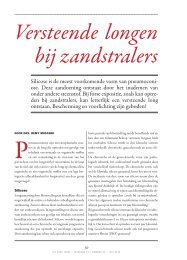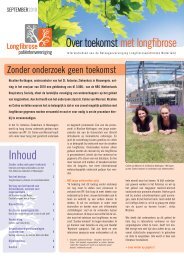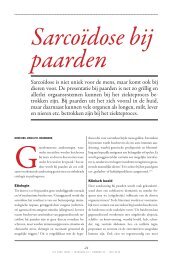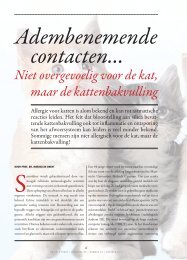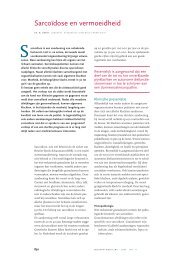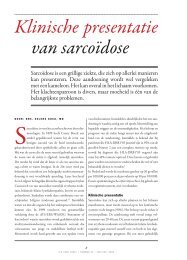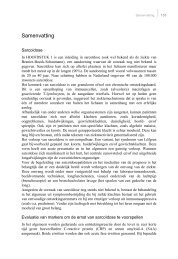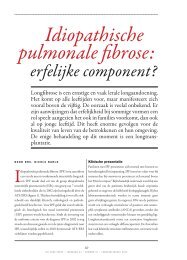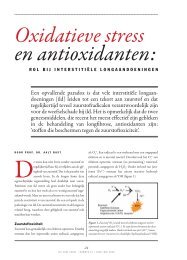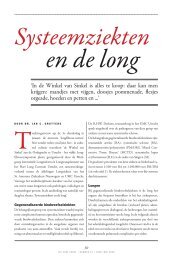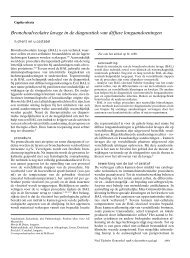Interpretation of bronchoalveolar lavage fluid cytology - ILD care
Interpretation of bronchoalveolar lavage fluid cytology - ILD care
Interpretation of bronchoalveolar lavage fluid cytology - ILD care
You also want an ePaper? Increase the reach of your titles
YUMPU automatically turns print PDFs into web optimized ePapers that Google loves.
<strong>Interpretation</strong> <strong>of</strong> BALF <strong>cytology</strong><br />
Computer program supporting the diagnostic accuracy <strong>of</strong><br />
cellular BALF analysis: a new release<br />
Marjolein Drent<br />
Jan A. Jacobs<br />
Nicolle A.M. Cobben<br />
Ulrich Costabel<br />
Emiel F.M. Wouters<br />
Paul G.H. Mulder<br />
Abstract<br />
Background - Recently, we developed a validated computer program based on polychotomous logistic regression<br />
analysis using <strong>bronchoalveolar</strong> <strong>lavage</strong> <strong>fluid</strong> (BALF) results to distinguish between the three most common<br />
interstitial lung diseases (<strong>ILD</strong>): sarcoidosis, idiopathic pulmonary fibrosis (IPF) and extrinsic allergic alveolitis (EAA)<br />
or drug-induced pneumonitis. One <strong>of</strong> the limitations <strong>of</strong> this program was that it was not useful in discriminating<br />
between infectious disorders and non-infectious disorders.<br />
Study design - Therefore, we added BALF samples obtained from patients with a confirmed bacterial pulmonary<br />
infection based on culture results > 10 4 cfu.ml -1 (Group I: n=31) to the study population mentioned above (Group II:<br />
n=272).<br />
Results - Notably, just one variable, i.e. the percentage polymorphonuclear neutrophils, allowed to distinguish<br />
between infectious and non-infectious disorders. The agreement <strong>of</strong> predicted with the actual diagnostic group<br />
membership was 99.67% (Group I and Group II). Additionally, 91.2% <strong>of</strong> the cases with <strong>ILD</strong> were correctly classified.<br />
Conclusion - This updated windows version 2000 <strong>of</strong> the validated computer program provides a very reliable<br />
prediction <strong>of</strong> the correct diagnosis for an arbitrary patient with suspected pneumonia or with <strong>ILD</strong> given information<br />
obtained from BALF analys is results, and is thought to improve the diagnostic power <strong>of</strong> BALF analysis.<br />
Respir Med 2001: 95: 781-786.<br />
Introduction<br />
Diffuse interstitial lung disease (D<strong>ILD</strong>) poses a significant challenge for the clinician because the aetiology is <strong>of</strong>ten<br />
unknown [1,2]. To establish the diagnosis a thorough history is essential as it may identify a potential etiologic<br />
factor. Many diagnostic procedures are useful, in particular a high-resolution computed tomography (HRCT) scan<br />
and a <strong>bronchoalveolar</strong> <strong>lavage</strong> (BAL) [1]. A BAL readily explores large areas <strong>of</strong> the alveolar compartment providing<br />
cells, as well as noncellular constituents from the lower respiratory tract. Therefore, BAL represents an additional<br />
tool in assessing diseases involving the lung parenchyma. After the introduction as a research tool, BAL has been<br />
appreciated extensively for clinical applications [3,4]. When applied according to standardized protocols, and,<br />
considered in the context <strong>of</strong> other information from conventional ancillary diagnostic tests, BAL appears to be useful<br />
in the diagnosis <strong>of</strong> D<strong>ILD</strong>, pneumonia, especially opportunistic infections, and, sometimes malignancies with<br />
pulmonary localisation [3-7]. Careful analysis <strong>of</strong> the cellular BAL <strong>fluid</strong> (BALF) pr<strong>of</strong>ile, together with a thorough<br />
evaluation <strong>of</strong> clinical and radiological features, allows prediction <strong>of</strong> the underlying disorder or ruling out a diagnosis<br />
with a high sensitivity and specificity [4]. In this respect, it has the advantage <strong>of</strong> avoiding more invasive diagnostic<br />
procedures, such as tissue biopsies.<br />
If the clinician decides that a BAL might be helpful to provide diagnostic material it is mandatory to have reliable<br />
diagnostic criteria. Therefore, the interpretation <strong>of</strong> cellular BALF analysis results has to be standardized to improve<br />
the diagnostic power. Previously, we studied cellular BALF data from a large cohort <strong>of</strong> patients suffering from either<br />
sarcoidosis, extrinsic allergic alveolitis (EAA) or idiopathic pulmonary fibrosis (IPF). A logistic regression equation<br />
was constructed, using several BALF parameters as variables to provide the most likely diagnosis [8,9]. The<br />
diagnosis had been established independently <strong>of</strong> the BALF-analysis results. The variables used to discriminate<br />
among these patient groups were the yield <strong>of</strong> recovered BALF, total cell count, and percentages <strong>of</strong> alveolar<br />
macrophages, lymphocytes, neutrophils, and eosinophils. This equation appeared to be accurate in 91.2% <strong>of</strong> the<br />
cases. To date, inclusion <strong>of</strong> the BALF CD4/CD8 ratio in the analysis did not result in a better prediction. However,<br />
one <strong>of</strong> the limitations <strong>of</strong> this logistic regression equation was - among others - that it was not useful to distinguish<br />
disorders <strong>of</strong> infectious aetiology and non-infectious aetiology [8,9]. Furthermore, JACOBS et al. demonstrated the<br />
value <strong>of</strong> BALF cytological findings for the diagnosis <strong>of</strong> non-infectious conditions in patients with suspected<br />
pneumonia [7]. In line with this, COBBEN et al. found that only one cellular variable, the number <strong>of</strong> polymorphonuclear<br />
Computer program using BALF variables: a new release. Drent at al. Respir Med 2001. 1



